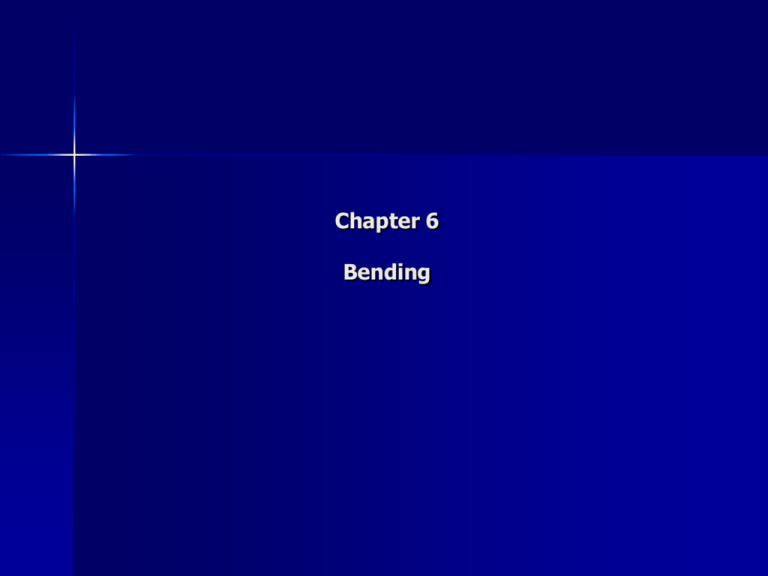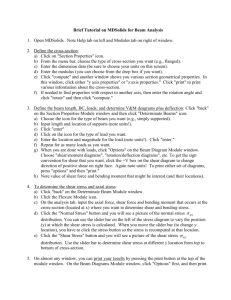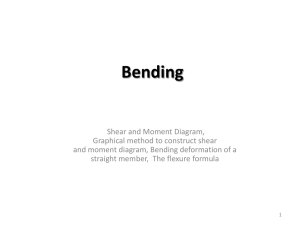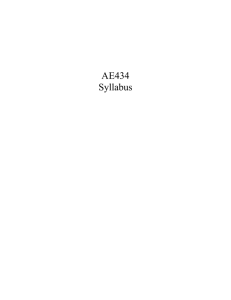Introduction to the Engineering Design Process
advertisement

Chapter 6 Bending Beams Members that are slender (length dimension >> width dimension) and support loadings that are applied perpendicular to their longitudinal axis are considered beams Beams develop internal shear force and bending moment that, in general, vary from point to point along the axis of the beam To properly design a beam it is necessary to first determine the maximum shear and bending moment in the beam – – σmax = Mc/I (the flexure formula) τ = VQ/It (the shear formula) Shear and Bending Moment Functions and Diagrams Method of sections is used to find the internal loading The imaginary section or cut must be located at an arbitrary distance x from the end of the beam and V and M formulated in terms of x Most often, the origin of x is located at the left end of the beam and the positive direction is to the right The internal V and M obtained as functions of x will be discontinuous, or their slope will be discontinuous, at points where a distributed load changes or where concentrated forces or couples are applied For this reason, V and M functions must be determined for each region of the beam located between any two discontinuities of loading Beam Sign Convention Positive directions are as follows – – – Distributed load acts downward on the beam Internal shear force causes a clockwise rotation of the beam segment on which it acts Internal moment causes compression in the top fibers of the beam segment (it bends the segment such that it holds water) Loadings opposite to these are considered negative Problems, pg 274 Relating the Magnitude and Slope of Distributed Load, Shear, and Bending Moment Diagrams Consider the region of the beam subject to the distributed loading Slope of shear diagram at each point = - distributed load intensity at each point F y 0, as x 0, dV w(x) dx Slope of moment diagram at each point = shear at each point M o 0, as x 0, dM V dx Example Relating the Magnitude and Slope of Distributed Load, Shear, and Bending Moment Diagrams Relating the Change in Shear and Bending Moment to the Areas Under the Distributed Load and Shear Diagrams Previous equation relating slope of the shear diagram to the negative of the distributed load intensity can be rewritten – – – dV = - w(x) dx, where w(x) dx represents a differential area under the distributed loading diagram ΔV = - ∫ w(x) dx Change in shear = - area under the distributed loading Previous equation relating slope of the bending moment diagram to the shear can be rewritten – – – dM = V dx, where V dx represents a differential area under the shear diagram ΔM = ∫ V(x) dx Change in bending moment = area under the shear diagram Regions of Concentrated Force and Moment When concentrated force, F, acts downward on the beam, ΔV is negative so the shear will "jump" downward. Similarly, if F acts upward, ΔV is positive so the shear will "jump" upward. When Mo is applied clockwise (and letting Δx -> 0), ΔM is positive so the moment diagram will "jump" upward. Similarly, if Mo is applied counterclockwise, ΔM is negative so the moment diagram will "jump" downward. Problems, pg 274 Bending Deformation of a Beam Assumptions – – – The longitudinal axis, which lies within the neutral surface, does not experience any change in length (the neutral surface is the surface in which the longitudinal fibers do not undergo a change in length) All cross sections of the beam remain plane and perpendicular to the longitudinal axis during the deformation Any deformation of the cross section within its own plane will be neglected An Element from the Deformed Beam y lim Δs' Δs lim (ρ y) Δ θ - ρΔθ Δθ 0 Δs Δθ 0 ρΔθ ρ the longitudin al strain will vary linearly w ith y from the neutral axis ε Variation of Longitudinal Normal Strain and Stress A linear variation of normal strain must be the consequence of a linear variation in normal stress Since ε max c ρ y/ρ y or ε ε max ε max c/ρ c assuming Hooke' s Law applies y σ σ max c ε The Flexure Formula The resultant force acting on the cross section must be equal to zero (there is no applied force) The force acting on an arbitrary element dA is dF = σ dA σ y 0 df σ dA σ max dA max ydA c A c A A A since σ max /c is not equal to zero ydA 0 A this can only occur if the neutral axis is located at the centroidal axis The stress in the beam can be determined from the requirement that the resultant internal moment M must be equal to the moment produced by the stress distribution about the neutral axis σ y M y dF y σ dA y σ max dA max y 2 dA A A since y dA I A c c A 2 A σ max Mc My or σ (in region where y is positive compressio n stress) I I Problems, pg 294








